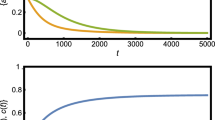Summary
Some strong-migration limits are established for geographically structured populations. A diploid monoecious population is subdivided into a finite number of colonies, which exchange migrants. The migration pattern is fixed and ergodic, but otherwise arbitrary. Generations are discrete and nonoverlapping; the analysis is restricted to a single locus. In all the limiting results, an effective population number N e (⩽ N T ) appears instead of the actual total population number N T . 1. If there is no selection, every allele mutates at rate u to types not preexisting in the population, and the (finite) subpopulation numbers N i are very large, then the ultimate rate and pattern of convergence of the probabilities of allelic identity are approximately the same as for panmixia. If, in addition, the N i are proportional to 1/u, as N T →∼8, the equilibrium probabilities of identity converge to the panmictic value. 2. With a finite number of alleles, any mutation pattern, an arbitrary selection scheme for each colony, and the mutation rates and selection coefficients proportional to 1/N T , let P j be the frequency of the allele A j in the entire population, averaged with respect to the stationary distribution of the backward migration matrix M. As N T → ∼8, the deviations of the allelic frequencies in each of the subpopulations from P j converge to zero; the usual panmictic mutation-selection diffusion is obtained for P j , with the selection intensities averaged with respect to the stationary distribution of M. In both models, N e = N T and all effects of population subdivision disappear in the limit if, and only if, migration does not alter the subpopulation numbers.
Similar content being viewed by others
References
Dempster, E. R.: Maintenance of genetic heterogeneity. Cold Spring Harbor Symp. Quant.Biol.20, 25–32 (1955)
Ethier, S. N., Nagylaki, T.: Diffusion approximations of Markov chains with two time scales and applications to population genetics. Adv. Appl. Prob., in press (1980)
Feller, W.: An Introduction to Probability Theory and Its Applications, 3rd edition, Vol. I. New York: Wiley, 1968
Franklin, J. N.: Matrix Theory. Englewood Cliffs, N.J.: Prentice-Hall, 1968
Gantmacher, F. R.: The Theory of Matrices, 2 vol. New York: Chelsea, 1959
Karlin, S., Taylor, H. M.: A First Course in Stochastic Processes, 2nd edition. New York:Academic Press, 1975
Kimura, M.: Diffusion models in population genetics. J. Appl. Prob, 1, 177–232 (1964)
Kimura, M., Crow, J. F.: The number of alleles that can be maintained in a finite populationGenetics 49, 725–738 (1964)
Malécot, G.: Les mathématiques de l'hérédité. Paris: Masson 1948. Extended translation Malécot, G.: The Mathematics of Heredity. San Francisco: Freeman, 1969
Malécot, G.: Un traitement stochastique des problèmes linéaires (mutation, linkage, migration)en Génétique de Population. Ann. Univ. Lyon, Sciences, Sec. A 14, 79–117 (1951)
Nagylaki, T.: Selection in One and Two-Locus Systems. Berlin: Springer-Verlag, 1977
Nagylaki, T.: Decay of genetic variability in geographically structured populations. Proc. Natl.Acad. Sci. USA 74, 2523–2525 (1977a)
Nagylaki, T.: A diffusion model for geographically structured populations. J. Math. Biol. 6, 375–382 (1978)
Sawyer, S.: Results for the stepping-stone model for migration in population genetics. Ann.Prob. 4, 699–728 (1976)
Wallace, B.: Topics in Population Genetics. New York: Norton 1968
Wright, S.: Evolution in Mendelian populations. Genetics 16, 97–159 (1931)
Author information
Authors and Affiliations
Additional information
Supported by the National Science Foundation (Grant No. DEB77-21494)
Rights and permissions
About this article
Cite this article
Nagylaki, T. The strong-migration limit in geographically structured populations. J. Math. Biology 9, 101–114 (1980). https://doi.org/10.1007/BF00275916
Revised:
Issue Date:
DOI: https://doi.org/10.1007/BF00275916




